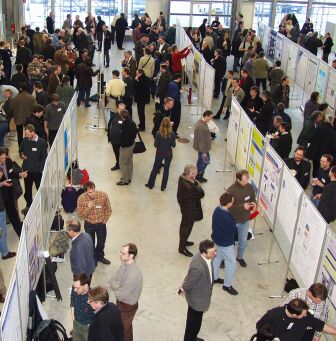URL: https://www.desy.de/news/news/archive_before_2010/2003/phot_3101/index_eng.html
Breadcrumb Navigation
HASYLAB Users' Meeting
HASYLAB-Nutzertreffen gibt einen Ausblick auf laufende und geplante Forschungsprojekte

The Hamburg Synchrotron Laboratory HASYLAB starts the new research year with great plans. Extension of the X-ray laser experiment VUV-FEL, upgrade of the storage ring PETRA to a radiation source of the third generation and further development of the X-ray laser X-FEL of the TESLA project are the desired goals. In the presence of about 280 participants of the HASYLAB Users' Meeting last Friday, Director Jochen R. Schneider gave a survey of the current status and perspectives of the projects.
The necessity to further develop the radiation sources was made evident by Schneider with the growing demand over the past years for excellent light sources. For materials science, life sciences, earth science and many other research fields, as well as for the industry, synchrotron radiation becomes an increasingly important instrument for the revelation of the smallest structures. HASYLAB does not only serve as a basis for many different research fields, the community of scientists is a variegated mixture too: approximately 1900 guest scientists from more than 30 countries collaborate at the Hamburg Synchrotron Laboratory.
Progress was announced by HASYLAB for the second stage of extension of the VUV-FEL, the free electron laser for soft X-rays range. The breakthrough between the TESLA test hall and the future accelerator tunnel is completed, and until summer, the TTF-team will have assembled the modules of the linear accelerator in the tunnel. Subsequently the new experimental hall will be completed.
The future project X-FEL, the free electron laser for the hard X-rays range has also made a decisive step forward. Based on a revision stipulated by the Science Council, the future X-ray laser X-FEL is designed to operate separately from the linear accelerator TESLA. A detailed insight on how this will work is described in the new Supplement of the TESLA Technical Design Report, which was produced with the collaboration of international experts.
A new age is also beginning for the storage ring PETRA. It is currently serving as a preaccelerator for the larger HERA-ring, but scientists have great plans for the ring. PETRA is designed to get a complete "face-lifting": an upgrade to an excellent radiation source of the third generation, exceeding the brilliance of the today's best source at the ESRF.
The good collaboration with the University of Hamburg became more intense. At the beginning of this year, the employees of the Institute for Laser-Physics could move from the university campus to their new building on the DESY campus. "Both parties want a closer cooperation" reported Schneider with satisfaction. He hopes for promising synergies of both laboratories with regard to the FEL activities at DESY.


